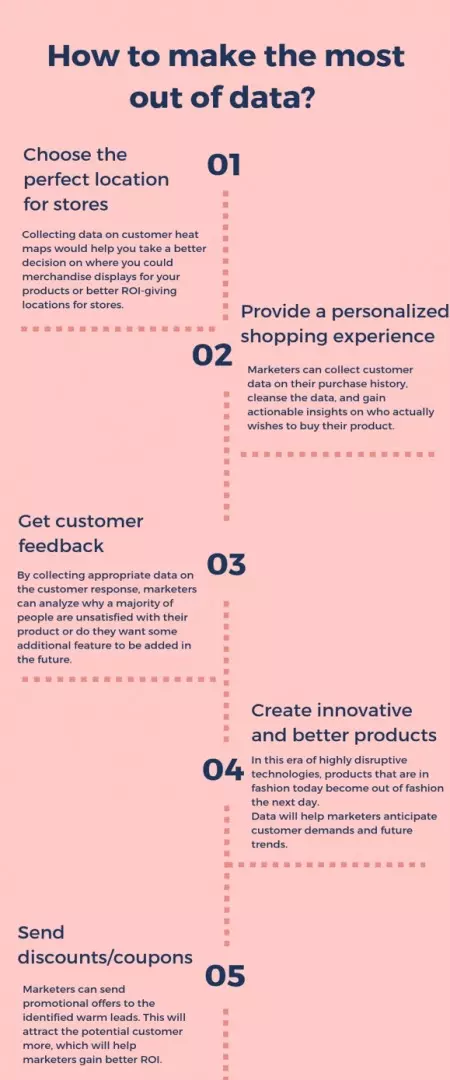Comments
- No comments found

Data-driven marketing helps organizations make crucial business decisions.
But, in the pursuit to keep up with the pace of technological trends, most marketers often fail to make the most out of data they collect.
While the world is evolving to get digitized, marketers are also trying to be on the same plate. We see most of them jumping online and redefining their marketing practices and strategies. In today’s technology-driven world, the right way to fulfill the excruciating expectations of their customers is to give marketing the twist of technology. Those marketers who wouldn’t participate fully with technology fear to lose relevance in the marketplace. Hence, to go with the trend, marketers today are adopting the latest, most-relevant approach - the data-driven approach. Data, if analyzed thoroughly, has the potential to unleash customer behavioral patterns, which can then be used to adjust marketing strategies as per customer preferences. Having that target in mind, marketers collect data from all possible sources available to them, ranging from social media to purchase history. But what’s next after this? A majority of marketers stumble at this point. A lot has to be done post data acquisition process, that usually remains undone. The report from Teradata says it all. “87% of marketers consider that their organization’s most underutilized asset is data.”
It's true that data has tons of room for bringing forth positive customer experiences and customer satisfaction across every touch point, but only if marketers make the most out of the data that is collected.
For marketers who have already climbed aboard the train named ‘data-driven marketing,’ and who are willing to get on it, should first analyze how they would make the most of data. Having said this, let’s mention concrete ways to make the maximum of what marketers call ‘the lifeblood of the organization - data.’

Marketers can collect customer data on their purchase history, cleanse the data, and gain actionable insights on who actually wishes to buy their product. By focusing on individual customers rather than the mass, marketers can remain unique in the customer’s mailbox, which will help marketers get more leads. Besides, promoting a brand to only the high-value customers and not focusing on the irrelevant ones will have a major impact on the organization’s financial savings.
Such niche data would help marketers improve their products and services in the future. Improved products will leave a positive experience, thereby impressing customers and making them happy. By word of mouth, these customers will help marketers in their customer acquisition program also.
Data has become an important agenda for corporates today if they wish to see maximum gains in terms of business efficiency, performance, and revenue growth. But the question here is, are they making the most out of data? To fully exploit the data capabilities, organizations should: identify, collect, cleanse, and manage big data from various different rich sources. Organizations should also develop an advanced analytics platform to streamline operations, anticipate demands, become a competitive differentiator and prepare for a makeover.
Organizations need to focus on developing a new strategy for unlocking the maximum data potential, and choosing the right technologies, like predictive analytics.
Along with this, organizations should also have a clear objective of what their marketing team actually desires. Once a list of goals is ready, they should take support from the skilled IT professionals to seek information on how data can help them attain their goals. After this, organizations should redefine their infrastructure and make it flexible and data ready. Legacy IT architecture may not support the unstructured data. Hindrance in assimilating siloed data can put a negative impact on analysis later.
The next step should be data collection. Better and richer data would help marketers gain a granular view of their customer’s interests and preferences. Data is essential, but most importantly organizations should have the right people who work on it. Hence, regular training should be undertaken by professionals to skill and upskill employees. Doing this, organizations can ensure that the collected big data and the analytics process work synchronized. With a highly trained team of experts, organizations can build analytics models that would help them unlock maximum value possible with data.
Naveen is the Founder and CEO of Allerin, a software solutions provider that delivers innovative and agile solutions that enable to automate, inspire and impress. He is a seasoned professional with more than 20 years of experience, with extensive experience in customizing open source products for cost optimizations of large scale IT deployment. He is currently working on Internet of Things solutions with Big Data Analytics. Naveen completed his programming qualifications in various Indian institutes.
Leave your comments
Post comment as a guest